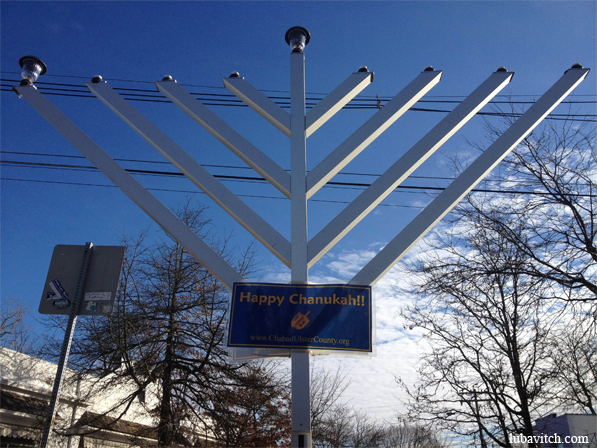It’s that time of year again: When public schools everywhere cast about desperately for a holiday celebration that doesn’t involve Jesus or a dude in a red suit; when families gather from thither and yon to spend a few days remembering why they’ve scattered thither and yon in the first place; and yes, it’s time to take stock of the year past, and look ahead to the one coming up. As the guy charged with keeping an eye on all things urban around here, I curled up with my laptop on a winter’s night that was definitely not as cold as they used to be, dug through the archives, and now offer this, my most humble (and totally non-denominational) retrospective of 2011.
The promise of 2011: “bright flight”
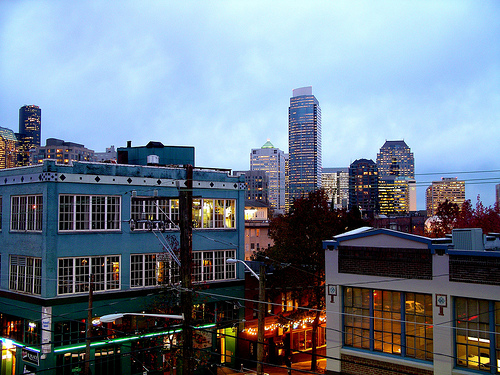 The view from Seattle’s Capitol Hill.Photo: Matthew RutledgeWith Millennials and Baby Boomers both expressing interest in more urban living, it looked like 2011 would usher in the “triumph of the city,” to borrow the title from a book released this year by Harvard economist Edward Glaeser. Between-year Census numbers released last year suggested that, for the first time in a generation in many metropolitan areas, white people were shunning the suburbs in favor of city living. “A new image of urban America is in the making,” William Frey, a demographer with the Brookings Institution, told the Associated Press. “What used to be white flight to the suburbs is turning into ‘bright flight’ to cities that have become magnets for aspiring young adults who see access to knowledge-based jobs, public transportation, and a new city ambience as an attraction.” It was music to many city leaders’ ears, and great news for the planet, too, as tightly packed, car-free living is what a green future looks like for many of us. But wait, there’s more …
The view from Seattle’s Capitol Hill.Photo: Matthew RutledgeWith Millennials and Baby Boomers both expressing interest in more urban living, it looked like 2011 would usher in the “triumph of the city,” to borrow the title from a book released this year by Harvard economist Edward Glaeser. Between-year Census numbers released last year suggested that, for the first time in a generation in many metropolitan areas, white people were shunning the suburbs in favor of city living. “A new image of urban America is in the making,” William Frey, a demographer with the Brookings Institution, told the Associated Press. “What used to be white flight to the suburbs is turning into ‘bright flight’ to cities that have become magnets for aspiring young adults who see access to knowledge-based jobs, public transportation, and a new city ambience as an attraction.” It was music to many city leaders’ ears, and great news for the planet, too, as tightly packed, car-free living is what a green future looks like for many of us. But wait, there’s more …
The urban renaissance that isn’t (yet)
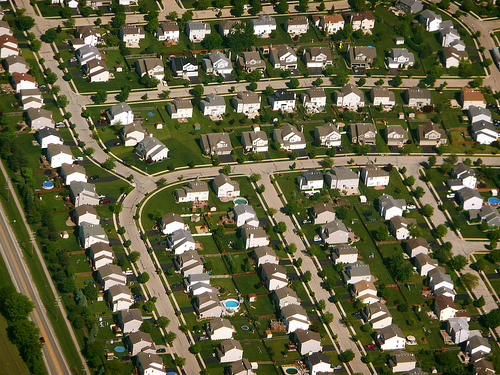 Chicago’s in it for the long sprawl. Photo: Scorpions and CentaursWhen the final 2010 Census came in, it made clear that the renaissance had not arrived yet — at least not in any statistically meaningful way. An analysis of eight metro areas, including Chicago, Washington, D.C., and Austin, revealed that in the past decade, 96 percent of the population growth occurred in the suburbs. Some took great exception to this number crunching, arguing that it lumped a number of full-fledged cities in with the ‘burbs. But while the Census, stripped of much of the nuance that it had contained in previous years, painted a rather fuzzy picture, there was little to suggest any inmigraiton into urban centers. The will was there, it seemed, but with suburban home prices in the toilet and the job market in the tank, Americans just weren’t finding a way to extract themselves from the ‘burbs and make the leap back to the city. Back in the car, kids. Looks like this is going to be a longer haul than we’d hoped …
Chicago’s in it for the long sprawl. Photo: Scorpions and CentaursWhen the final 2010 Census came in, it made clear that the renaissance had not arrived yet — at least not in any statistically meaningful way. An analysis of eight metro areas, including Chicago, Washington, D.C., and Austin, revealed that in the past decade, 96 percent of the population growth occurred in the suburbs. Some took great exception to this number crunching, arguing that it lumped a number of full-fledged cities in with the ‘burbs. But while the Census, stripped of much of the nuance that it had contained in previous years, painted a rather fuzzy picture, there was little to suggest any inmigraiton into urban centers. The will was there, it seemed, but with suburban home prices in the toilet and the job market in the tank, Americans just weren’t finding a way to extract themselves from the ‘burbs and make the leap back to the city. Back in the car, kids. Looks like this is going to be a longer haul than we’d hoped …
The exurban collapse that is (maybe)
Photo: Barrie SutcliffeAmericans (and their personal fortunes) may still be tied up the suburbs, but the farthest exurban fringes do seem to have taken a serious, possibly fatal, hit — at least if real estate prices are any indication. An analysis of Zillow’s real estate database by the Brookings Institution (yes, they’re the same folks who brought us “bright flight,” so take this with a grain of salt) shows that the most expensive neighborhoods in the nation are dense, urban areas such as Seattle’s Capitol Hill and Logan Circle in Washington, D.C. Meanwhile, the price of many houses in fringe neighborhoods are now below replacement value. Christopher Leinberger, who did the study for Brookings, argued in a recent New York Times op-ed that this devaluation means that the exurbs will quickly turn into slums. Of course, you could also argue that this is just one more reason people will stay where they are: Why would you sell your place in the ‘burbs for a pittance when it’s not going to buy you half of a house in the city? Time will tell. Meantime, if you’re looking for a screaming deal on a McMansion well out of biking range of town, have I got a deal for you …
The reason city living is super — and supergreen
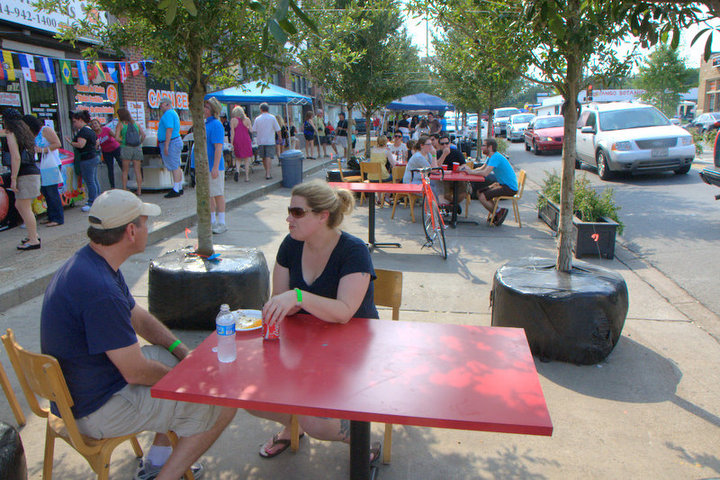 Tactical urbanism: With a few trees, some sidewalk tables, and lots of community input, a Dallas street was transformed.Photo: Go Oak CliffLest you start getting cold feet about cities, there really is a tremendous amount of energy and creative thought pouring forth from our urban centers these days, the Census be damned. This year, we brought you a veritable blizzard of stories on green building, urban farming, growing bike networks (more on those coming in a bike-tastic retrospective soon!), public transportation, tactical urbanism, street art, and, most recently, neighborhood-level experiments in sustainability. In the absence of real progress on climate change at the state and national levels, cities have led the charge, cutting back their greenhouse gas emissions Kyoto-Protocol-style, to hell with the fat cats in Washington. But the cutting edge is more hyper-local still. Across the country, communities are finding ways to trim down their impact on a local level. And I’m not just talking about recycling and turning off the lights. In Seattle, a high-performance downtown building district aims to cut energy consumption, water use, and transportation-related CO2 emissions to 50 percent of national averages by 2030. In Denver and Brooklyn, efforts are underway to create city blocks that operate as single, interconnected systems, saving gobs of energy and resources in the process. And OK, props to the small towns — and even the suburbs — that are doing strong work too.
Tactical urbanism: With a few trees, some sidewalk tables, and lots of community input, a Dallas street was transformed.Photo: Go Oak CliffLest you start getting cold feet about cities, there really is a tremendous amount of energy and creative thought pouring forth from our urban centers these days, the Census be damned. This year, we brought you a veritable blizzard of stories on green building, urban farming, growing bike networks (more on those coming in a bike-tastic retrospective soon!), public transportation, tactical urbanism, street art, and, most recently, neighborhood-level experiments in sustainability. In the absence of real progress on climate change at the state and national levels, cities have led the charge, cutting back their greenhouse gas emissions Kyoto-Protocol-style, to hell with the fat cats in Washington. But the cutting edge is more hyper-local still. Across the country, communities are finding ways to trim down their impact on a local level. And I’m not just talking about recycling and turning off the lights. In Seattle, a high-performance downtown building district aims to cut energy consumption, water use, and transportation-related CO2 emissions to 50 percent of national averages by 2030. In Denver and Brooklyn, efforts are underway to create city blocks that operate as single, interconnected systems, saving gobs of energy and resources in the process. And OK, props to the small towns — and even the suburbs — that are doing strong work too.
Viva la Occupation!
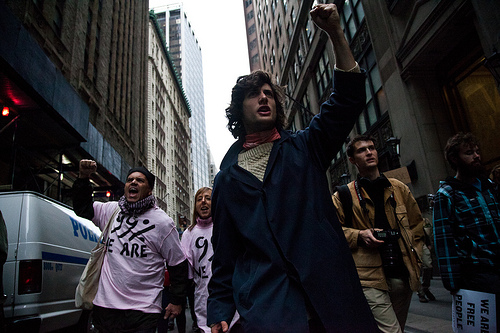 Photo: Lauren DeCicca via weeklydigI would be remiss to talk about cities in 2011 without mentioning Occupy Wall Street and its many offshoots in cities around the country. While there were a handful of occupations in the boonies, the Occupy movement itself was a powerfully urban phenomenon, a youth-driven movement that had its seeds in the cultural hothouses of American cities. And the clearing out of the protesters by urban police departments will help propel the movement forward even as the original encampments fade. What the 99% will do next is only just beginning to take form, but these kids showed that they have something to say — and know how to make themselves heard. Let’s just hope the good people running for public office this year are paying attention.
Photo: Lauren DeCicca via weeklydigI would be remiss to talk about cities in 2011 without mentioning Occupy Wall Street and its many offshoots in cities around the country. While there were a handful of occupations in the boonies, the Occupy movement itself was a powerfully urban phenomenon, a youth-driven movement that had its seeds in the cultural hothouses of American cities. And the clearing out of the protesters by urban police departments will help propel the movement forward even as the original encampments fade. What the 99% will do next is only just beginning to take form, but these kids showed that they have something to say — and know how to make themselves heard. Let’s just hope the good people running for public office this year are paying attention.
The promise of 2011: Cities will lead, and the people will push
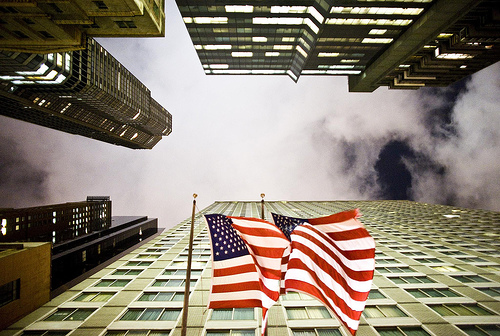 Cities: The final frontier?Photo: Thomas HawkAs the international climate talks in Durban sputtered and fizzled, and the Republican presidential field competed to out-deny the competition, it became ever more clear that if cities don’t lead, no one will. “As mayors — the great pragmatists of the world’s stage and directly responsible for the well-being of the majority of the world’s people — we don’t have the luxury of simply talking about change but not delivering it,” New York Mayor Michael Bloomberg told a gathering at the United Nations last week. If things continue as they have been, mayors like Bloomberg will have growing clout on the national and international stage. That’s thanks in part to the protesters whom Bloomberg chased out of Zuccotti Park last month, who have changed the national dialog to focus on issues of inequality and justice. It’s also because of a very real generational shift toward cities as the national ideal. Fifty years ago, America was a nation obsessed with the suburbs. Now, we are beginning to turn back to cities, investing in more sustainable ways of living and finding here-and-now solutions to the problems ahead. These are promising signs, and if the stars align, maybe, just maybe, we’ll see that urban renaissance we’ve all been rooting for. The country and the planet will be all the better for it. Here’s to 2012.
Cities: The final frontier?Photo: Thomas HawkAs the international climate talks in Durban sputtered and fizzled, and the Republican presidential field competed to out-deny the competition, it became ever more clear that if cities don’t lead, no one will. “As mayors — the great pragmatists of the world’s stage and directly responsible for the well-being of the majority of the world’s people — we don’t have the luxury of simply talking about change but not delivering it,” New York Mayor Michael Bloomberg told a gathering at the United Nations last week. If things continue as they have been, mayors like Bloomberg will have growing clout on the national and international stage. That’s thanks in part to the protesters whom Bloomberg chased out of Zuccotti Park last month, who have changed the national dialog to focus on issues of inequality and justice. It’s also because of a very real generational shift toward cities as the national ideal. Fifty years ago, America was a nation obsessed with the suburbs. Now, we are beginning to turn back to cities, investing in more sustainable ways of living and finding here-and-now solutions to the problems ahead. These are promising signs, and if the stars align, maybe, just maybe, we’ll see that urban renaissance we’ve all been rooting for. The country and the planet will be all the better for it. Here’s to 2012.
